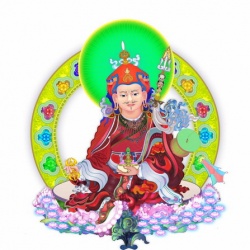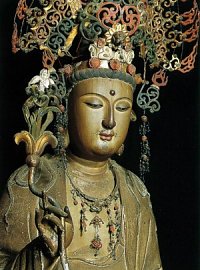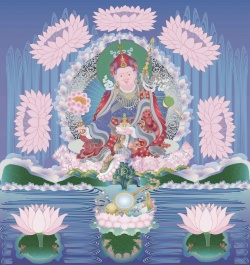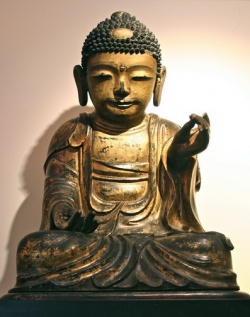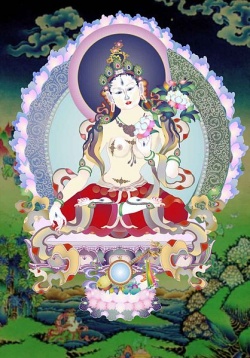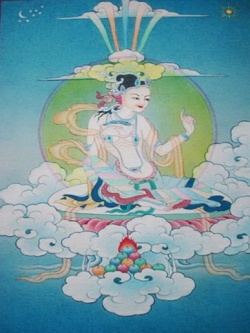Irigaray’s Meditations on the Duality of Sexuality in Buddhist Ethics Sokthan Yeng
By Sokthan Yeng
I suggest that the tension surrounding Irigaray’s interpretation of Tantric sexual meditation practices can be helpful for understanding how both Irigaray and Buddhist thinkers link sexuality to dualism—positively in the former and negatively in the latter. Contemporary Western debates about the merits or demerits of Irigarayan ethics can obfuscate this integral connection between sexuality and dualism. A Buddhist critique of Irigaray, however, can point to the problems within her ethics while being mindful of the relationship that she sought to establish. Likewise, Irigaray’s insightful reading of Buddhism can help show why Buddhists would resist sexuality not necessarily because it is associated with sin, as it often is in the West, 1 Philosophy Department, Adelphi University.
but because of the dualism that they think accompanies it. In other words, contrasting Irigaray’s ethics of sexual difference with Buddhist ethics can provide a deeper understanding and appreciation of both.
Luce Irigaray, like many contemporary feminist philosophers, reimagines the relationship between Woman and the body. She develops her theories about the “sensible transcendental” in response to the longheld notion that women, because the body and nature define them, are inferior to men.2 Irigaray suggests that the physical and carnal can provide, rather than inhibit, access to the divine. By thinking the sensible and the divine together, the (female) body becomes valorized and serves as a model for relational ethics. Finding few resources in the history of Western thought, she turns to Buddhist traditions and their focus on breath, in particular, to help flesh out her ethical philosophy. Because Buddhist meditations on breath have greatly influenced Irigaray’s ethics, an understanding of how Buddhists draw ethical principles from such meditations would help elucidate why she worked to integrate Buddhist philosophy into her own thought. Exploring similarities between Irigarayan and Buddhist ethics also reveals her novel reading of Buddhism and her attempt to distance herself from the tradition of Western ethics, which—according to Irigaray—degrades the body and revolves around the atomized self. Irigaray, unlike many Western philosophers who want to read Buddhism through the lens of virtue ethics3 or consequentialist theory,4 uses meditation practices as a key to under- 2 See Irigaray’s An Ethics of Sexual Difference and Sexes and Genealogies. 3 See Damien Keown’s The Nature of Buddhist Ethics. 4 To be more specific, Charles Goodman argues that a productive dialogue could be had between Buddhist ethics and rule-consequentialism. Yeng, Irigaray’s Meditations on the Duality of Sexuality in Buddhist Ethics 206 stand Buddhist ethics and to develop an ethics that properly recognizes the body and makes room for the relational self. Despite Irigaray’s integration of Buddhist thought into her own, differences between these two should not be ignored because they can provide an even deeper understanding of both philosophies. Irigaray does admire how Buddhist meditation brings attention to the body as a foundation for ethics but she also criticizes traditional forms of Buddhism for not fully unlocking the potential of the body in building an ethics because they ignore sexuality or see it as a hindrance to ethical life.
Only practitioners of Tantrism, in Irigaray’s view, incorporate sexuality into their meditation practices in order to create a dualistic self that affirms both the individual self and relational self while maintaining the difference between the two. Greater knowledge of Tantric culture, however, leads to the conclusion that Tantrism is much more conventional than Irigaray’s reading may lead us to believe. Tantrism, like other forms of Buddhism, see sexuality as a problem and use sexuality to work towards the dissolution of the self. I suggest that the tension surrounding Irigaray’s interpretation of Tantric sexual meditation practices, however, can be helpful for understanding how both Irigaray and Buddhist thinkers link sexuality to dualism, although Irigaray does this positively whereas Buddhist thinks do it negatively. Contemporary Western debates about the merits or demerits of Irigarayan ethics can obfuscate this integral connection between sexuality and dualism. A Buddhist critique of Irigaray, on the other hand, can point to the problems within her ethics while being mindful of the relationship that she sought to establish. Likewise, Irigaray’s insightful reading of Buddhism can help show why Buddhists would resist sexuality not necessarily because it is associated with sin—as it often is in the West—but because of the dualism that they think accompanies it. In other words, contrasting Irigaray’s ethics of sexual difference with Buddhist ethics can provide a deeper understanding and appreciation of both.
Lessons Learned from Buddhism
Irigaray proclaims that she has learned much from Buddhism through the way of breath. By meditating on breath, she explores an aspect of Buddhist ethics that she believes sets them apart from Western ethics. Western analyses of Buddhist ethics are hardly rare but I believe Irigaray’s examination offers an important contribution to the field because meditation is seldom the focus for Western thinkers who engage in such comparative studies.5 Because Irigaray begins her engagement with Buddhism through an examination of a valued Buddhist practice,6 this helps her to avoid a common tendency to reduce Buddhist thought to Western thought. She also uses meditation for insights about how the relational self operates within Buddhist ethics. Irigaray remains true to Buddhism by seeking to explore how focus on breath can lead to physical and metaphysical insights about the nature of reality. Because we share breath, we also share life. For both Buddhists and Irigaray, grasping the 5 Although there is value in relating Buddhist ethics to familiar ethical systems, Jay Garfield warns that such attempts could easily lead to the assimilation of Buddhist ethics into Western ethics. Irigaray resists reducing Eastern ethics to Western ethics by using meditation rather than utilitarian or consequentialist principles to enter into a dialogue with Buddhist thought.
6 Georges Dreyfus also seeks to compare Eastern and Western thought by examining meditation practices, which he believes are not adequately addressed by scholars. Whereas he wants to show the ethical nature of meditation without necessarily asserting that meditation is good (30), the benefits of meditation for ethics are central to Irigaray’s examination of Eastern thought.
Yeng, Irigaray’s Meditations on the Duality of Sexuality in Buddhist Ethics 208 interconnectedness of being is necessary to act and live ethically as it points to the necessity of approaching life with an attitude of sharing. Noted scholars and practitioners of Buddhism such as Thich Nhat Hanh believe that breath meditation is a practical approach to ethics. Nhat Hanh suggests that ethics begins by paying attention to the present and seeing the world clearly. This is often a difficult task because many people live a life of distraction. The desire to multi-task and see the world as we would like it to be rather than the way that it is takes us away from the here and now. Buddhists suggest that the very concrete exercise which calls for concentration on breath can help bring the present into focus. Nhat Hanh explains, “Breath itself. Breathing. It comes to many as astonishing news that something as simple as attention to breathing has a central part to play in meditation and prayer” (106). Instead of demonizing the body or pretending that it is not a part of the self, Buddhist thinkers sought to give this simple bodily function more attention as a means to cultivate ethics.
Meditation on breath can aid in finding or maintaining equanimity, which then leads to a greater ability to recognize the interconnectedness of all things and to respond to others with compassion. Exercises that concentrate on breathing are, in short, simple ways to bring the perspective of the meditator back to a basic reality of life that can often be lost. Therefore, he recommends meditation on breath for beginners and advanced practitioners alike because it helps the meditator to develop an ethical disposition. A friend and disciple of Thich Nhat Hanh elucidated this point nicely through a story about a talk on Vietnamese-American policy. When an angry man confronted Nhat Hanh about American involvement in Vietnam, Nhat Hanh was able to respond to anger with calm and engender compassion rather than hostility by focusing on his breath. Only by taking deep breaths could Nhat Hanh respond with calm and understanding, which, in turn, transformed the mood in the room from one of anger to compassion. (103-104) Nhat Hanh was able to change the mental and emotional states of everyone in the room because there is no true boundary between self and other. The relationship between self and other is what allows the way of breath to fill the room with calm. Irigaray, too, believes that although the act of breathing seems so simple it is often done badly and without much awareness, especially in the West. To combat the philosophical degradation of the body, she turned to Buddhist thought to rework the sensible into her own philosophy.
She states, “The body is no longer educated to develop its perceptions spiritually, but to detach itself from the sensible for a more abstract, more speculative, more sociological culture. Yoga taught [me] to return to the cultivation of sensible perception” (Between 71). While there is a great deal to be learned through Buddhist practices, Irigaray believes that the way of breath, especially, provides a great entryway into insights that Westerners lack. She states, “In the East it is more common to remember that living is equivalent to breathing. And the Sages there care about acquiring a proper life through practicing a conscious breathing” (Between 72).
This is a lesson, according to Irigaray, that Westerners seem reluctant or afraid to learn. She asserts that Westerners breathe badly because they regard sharing breath as a danger (Between 116). When we breathe, we exhale a part of ourselves. Likewise, inhaling means breathing the breathe of others. Westerners want to avoid this because they view the sharing of breath as a contamination of the self with the other. In contrast, Buddhist traditions believe that it is an inescapable fact that breath connects all which lives. Those of Buddhist cultures can recognize this physiological and philosophical truth because the way of breath is part of their ancient tradition. Westerners continue to struggle with the idea of sharing breath and the idea of being interconnected. Irving Goh explains,
Yeng, Irigaray’s Meditations on the Duality of Sexuality in Buddhist Ethics 210 . . . according to Irigaray, it is through this cultivation of shared breath, or through our openness to share the air around us, that we can begin to be in touch, literally and figuratively, with the respective difference of each being, and thereby begin to recognize and respect our individual differences.
Irigaray’s Ambivalence Towards Buddhism
It is this issue of difference, however, that shows that Irigaray is not willing to follow Buddhism to the ultimate philosophical lesson behind meditation. Whereas Buddhists believe that meditations on breathing lead to realizing the ultimate relationality of self, Irigaray suggests that the way of breath reveals an individualized self alongside the relational self. In other words, she uses the way of breath to establish a dualistic concept of self. Despite praising how Buddhists resist placing strict boundaries between mind/body and spirit/flesh, she cannot support the underlying Buddhist effort to transcend such dualistic thinking.7 An examination of how Irigaray breaks with Buddhist thought helps to show the various couplings within her ethics.8 I suggest further that her efforts to defend dualism lead not only to a distorted view of Buddhism but also help ex- 7 Erin McCarthy explains that the mind-body relationship in the thought of Irigaray and Watsuji Tetsuro show that both offer an alternative to the dualistic concept of self (Beyond 212). I suggest, however, that Irigaray’s concept of self does not fully escape a dualistic paradigm. Even though Irigaray rejects splitting the self into the mind and the body, she insists that ethics forms a kind of dualism that requires both a relational and individual self.
8 These couplings include divides such as East/West, flesh/spirit, individual/relational self, and male/female.
plain how problems of privilege and opposition arise within her own ethics.
Whereas Buddhists work to highlight the connection between the mind and body, Irigaray uses breath meditation to establish the oftoverlooked importance of the body. She does not work to transcend dualism but to give value to the one that is thought to be the lesser of the pairing, reinforcing the two-ness of the coupling. The same goes, as we shall see, for the male/female dichotomy. The different trajectory of each ethic becomes all the more clear when Irigaray criticizes how most Buddhist traditions lack adequate conceptions of individuated and feminine self. Although Irigaray does astutely relay some weaknesses within Buddhist thought, Irigaray’s dualistic philosophy does not seem to be able to escape the tendency to oppose and privilege one side over the other—which Buddhists were able to anticipate through their efforts to undo dualistic thinking.
Irigaray appreciates that Buddhists do not believe that the mental is superior to the body or the physical, as is common in the in West. Yet, Irigaray employs a Buddhist conception of body more to show that the body is deserving of respect than to show the ultimate relationality of mind and body, which is the Buddhist aim. She charges that Western man has generally neglected, even forgotten, this ability. Separating body and spirit, he has valorized the one, as the result of a disincarnated speech, making of the other a vehicle, necessary but cumbersome, during existence said to be earthly. The spiritualization of the body and of the senses has not yet appeared to him as a specifically human task thanks to which he may transcend a material status, overcome suffering, solitude, illness.
Yeng, Irigaray’s Meditations on the Duality of Sexuality in Buddhist Ethics 212 Although Irigaray argues that Buddhists are right not to separate the spirit and the body, her engagement with Buddhist thought opens up a path to increase the status of the body. Part of her goal is to show that the body is not the repository of all things negative and that the body can play a part in ethics.
Because Westerners believe that the body is in opposition to the spirit and a hindrance to ethical goals, she turns to Buddhist cultures to find a way to connect the body and ethics. However, a Buddhist ethics of the body must be understood in conjunction with the principle of “noself,” 9 that there is no constant and discrete self. Attention to breath first alerts the practitioner to basic bodily movements of the self and eventually leads to the questioning of the static self and boundaries between seemingly distinct categories (mind/body and self/other). To notice the arrival and passing of feelings is to notice how the self changes from moment to moment. Because the self is constituted by aggregates, no component endures or belongs to one entity. The self is, instead, always changing because the relationality of the aggregates means that they are always in flux. Breath, like feeling or thought, is not only housed in a particular individual. It circulates and helps to shape life and existence in every moment. Our physical and psychical qualities, which we think make us unique individuals, are in reality aggregates that form, shift, and reform in various combinations.
9 Dreyfus is right to point out the difficulties in trying to create a systematic understanding of Buddhist ethics (30) but the principle of “no-self” does seem to be one that pervades all Buddhist traditions. Understanding the concept of “no-self” can, therefore, shed light on something that is fundamental to Buddhist ethics. In this paper, I will draw from various traditions to help elucidate how the aggregated self functions within Buddhist ethics in an effort to contrast it with concept of self in Irigaray’s ethics and her reading both of the Tantric self and what she more generally refers to as Eastern thought or culture.
Although Irigaray affirms the need for thinking the relational self, she also insists on a dualistic conception of self: there is in addition to the relational self an individual self. She cannot accept the idea that the self is always and only a compilation of physical and psychical aggregates. Instead, she suggests that the relationality of self does not preclude an individual self and that ethics requires both an individual self and a relational self. Her treatment of the relational self is an attempt to counter the Western over-emphasis on the individual self rather than a resounding endorsement of the Buddhist relational self. She does not outline the relational self, like Buddhists, in order to dispense altogether with the engrained notions of the individual self. Irigaray seeks, instead, to carve out a space between East and West by suggesting that the relational self must be respected but not to the detriment of the individual self. Irigaray explains, This breathing [also] brings [us] little by little to a second birth, a birth assumed by oneself, willed by oneself and not only by our parents, and a physiology that dictates its laws to us. Breathing in a conscious and free manner is equivalent to taking charge of one’s life, to accepting solitude through cutting the umbilical cord, to respecting and cultivating life, for oneself and for others. (Between 72) She challenges the concept of “no-self” by pointing to its negative repercussion for the community, which Buddhist cultures purportedly privilege over the individual. Irigaray argues that a prosperous community and compassion to the other is only possible if Buddhists foster the growth of the individuated self:
As long as we do not breathe in an autonomous manner, not only do we live badly but we encroach upon others in order to live. We remain confused with others, forming a Yeng, Irigaray’s Meditations on the Duality of Sexuality in Buddhist Ethics 214 sort of mass, a sort of tribe, where each individual has not yet conquered his personal life but lives on a collective social and cultural respiration, on an unconscious breathing of the group, beginning with that of the family. Although Irigaray has taken a novel path in interpreting Buddhist ethics by pursuing meditation, she concludes, like many Western critics of Buddhism, that the inability to recognize the individuated self causes problems for thinking autonomy because it erases difference, which in turn means that the self dissolves into the community and others.10 Having an insufficient understanding of self and the lack of self-identity, according to Irigaray, means that there cannot be proper respect for the other. If there is no space between self and other, there is always a danger of invasion or appropriation of the other. On the contrary, Buddhists hope that practitioners who dissolve the boundaries between self and other can cultivate an attitude of compassion toward others. Irigaray counters by suggesting that the inadequate concept of self can lead to the reduction of everything to self.
Although Irigaray may seem to favor Buddhist philosophy over Western thought through her treatment of the body and breath, she believes that ethics is only possible through a combination of Buddhist and Western self. The hints that her dualistic ethics reaffirms privilege and opposition become even stronger when she seeks to create a space for the feminine self. Incorporated within her sketch of the feminine self are indications that her dualistic framework, as Buddhists might have 10 Irigaray notes that Hegel has influenced her ideas of subjectivity (Between100). Here, perhaps there is also a nod to the Hegelian notion that those from the Orient have little individual personality and cannot move beyond the ethical principle of the family (Hegel 121-123) guessed, will ultimately fall prey to the degradation of one in favor of the other within a coupling. In her analysis of how better to recognize the feminine self, she begins to show greater preference not just for Buddhist cultures over Western ones but also for feminine identities over masculine ones.
According to Irigaray, Buddhist thinkers, because they have the framework to attribute greater merit to the body and the relational self, can better recognize the feminine. Part of the reason why women have a lowly status in Western thought is because they are so closely aligned with the body.11 If the body were not assigned such a poor position, it would seem to follow that women, too, could gain in esteem. Buddhist cultures have an added advantage over Western societies because Buddhist societies are more attuned to the feminine way of breath and its life-giving qualities. The West has yet to come to this insight. Still, she charges that those in the East do not fully appreciate the life-giving qualities of feminine breath. This potential within Buddhist thought, Irigaray suggests, remains cloaked because Buddhist philosophy rejects a dualistic conception of self.
Irigaray believes that women have a special place within Buddhism. She argues that women are more attuned and inclined to sharing— a property that is prized by Buddhists. However, because they are committed to the idea that all beings engage in a relational way of being, Buddhists cannot recognize these special properties of the feminine and how women are better able to share. She regrets that Buddhist communities are not true to the way of the Buddha, for he praises the feminine by bringing attention to the necessity and importance of her breath. Irigaray proclaims,
11 The notable exception, according to Irigaray, is Descartes (Ethics 72-82). Yeng, Irigaray’s Meditations on the Duality of Sexuality in Buddhist Ethics 216 Woman, faithful to herself, is close to Eastern cultures, close to the Buddha, who moreover venerates the feminine spiritual. Woman shares her breath. Either she remains at the level of vital breath, by giving oxygen to the fetus through her blood, or she shares spiritual breath.
Although it is obvious that men as well as women breathe, only the breath of woman gives and sustains life. Her reading of female breath is an attempt to show the value of feminine breath, as Buddhists may have guessed, turns quickly into the opposition and privileging of one over another within the coupling. Irigaray goes even further than creating value for feminine breath when she describes women as being better able to share breath and life than men, who in her estimation focus on individual breath and existence.
Although the image of a mother sharing and, therefore, giving life to the fetus in her womb serves as a particular physiological example of the power of female breath, Irigaray suggests that women share their breath with all that is living. Woman’s life-giving quality is due to her natural ability and willingness to share her breath with others. Irigaray further contrasts this way of breath with masculine breath that requires a space all his own and is unwilling or unaccustomed to sharing breath. She argues that girls have a different stance towards the world and others because they are more attuned to natural life:
The little girl is born with familiarity to self, to the natural world, to the other. She intuitively knows the origin of life. She knows that the source of life is in her, that she need not construct it outside of herself. Her breath need not leave her in order to build, to fabricate, to create. It needs, on the contrary, to remain in her to be able to be shared, to be made fertile. Woman also remains in greater harmony with the cosmos. This allows her to inhale and to exhale more naturally that which nourishes the vital breath: air.
If shared breath is the key not to just living but living in harmony with others, girls and women are better able than boys and men to cultivate this type of breath. Girls intuitively recognize the value in sharing breath because their mothers shared breath with them.12 By understanding the natural ability for women to share breath, girls begin to see themselves as those who can create and foster life.13 Because the Buddha acknowledged the power of breath, those in the East have an ethical model that better allows them to cultivate feminine breath and respect the nature of Woman. It is, as we shall see, precisely these points of opposition that Buddhists hope to transcend by asserting the universality of the relational self. Irigaray, on the other hand, uses the self/other and male/female split to highlight the de-privileged ones within the coupling and establish the importance of dualism in her ethics of sexual difference. Irigaray’s Turn to Tantrism
To recover Buddhist insights and point to how dualism works within Buddhism, Irigaray turns to sexual practices within Tantrism. Irigaray models her ethics on principles found in Tantric sexual practices, which 12 Whereas Freud suggests that little girls liken themselves to their mothers because they lack a penis (110), Irigaray argues that little girls see something positive in their similarities to their mothers—the ability to foster life. 13 Of course, Irigaray does not seek simply to reduce the value of women to their reproductive functions. See Malabou and Ziarek for an interpretation of Irigaray’s feminine through the lens of the possible.
Yeng, Irigaray’s Meditations on the Duality of Sexuality in Buddhist Ethics 218 recognize dualities by affirming the difference and relationship between the individual/relational self, body/spirit, and feminine/masculine. Although I will show that her attempt to find dualism within a Buddhist tradition distorts her reading of Tantrism, I also suggest that her reading of Tantrism elucidates why she believes that sexuality and dualism are inextricably linked. Precisely for this reason, Irigaray opens herself up to charges of privileging certain sexual identities over others. This, however, may be unsurprising to Buddhists because they believe that opposition and privilege are constant companions to dualistic thinking. Irigaray wants to show that the Tantric engagement with sexuality allows for thinking both the relational and individual self, unlike other Buddhist traditions that resist dualism in all forms. Although her efforts to join together breath and ethics is consistent with mainstream Buddhist teachings, she also means to integrate Tantric meditations into her own ethical model in order to create a foundation for a dualistic conception of self. What differentiates the Tantric tradition from more conventional forms of Buddhism is that it actively engages with sexuality and incorporates sexuality into its meditations. The link between sexuality and duality, which can be obscured in Western readings of Irigarayan ethics, is made clearer through the tension that Irigaray creates between what she deems to be conventional and countercultural Buddhism. While Buddhists do not always identify the sensual with the sinful, Irigaray is right to recognize that Buddhist texts and practices tend either to dismiss sexuality or to regard it as a problem that stems from unhealthy attachments. The Zen story about the “Muddy Road” (below) illustrates that sexuality can stir cravings of the flesh and cloud the mind. However, this story also shows that a focus on sexuality relays a problem of attachment. Because most Buddhists promote a stance of non-engagement, there is not enough attention paid to sexuality for Irigaray’s tastes. The main point of the story has less to do with sexuality and more to do with what is deemed to be a preoccupation with sexuality, which can manifest both by having too much interest or going to great lengths to avoid sexuality.
Tanzan and Ekido were once traveling together down a muddy road. A heavy rain was still falling.
Coming around a bend, they met a lovely girl in a silk kimono and sash, unable to cross the intersection.
“Come on, girl,” said Tanzan at once. Lifting her in his arms, he carried her over the mud.
Ekido did not speak again until that night when they reached a lodging temple. Then he no longer could restrain himself. “We monks don’t go near females,” he told Tanzan, “especially not young and lovely ones. It is dangerous. Why did you do that?”
“I left the girl there,” said Tanzan. “Are you still carrying her?” (Reps 18)
Ekido’s words reveal the traditional view that sexuality can challenge even cultivated monks to resist temptation and craving. He admonishes Tanzan for his physical contact with the lovely girl because it had the potential to awaken sexual desire. This Buddhist parable also suggests that the best ways to overcome cravings of the flesh is to avoid any possible sexual temptation. Of course, Tanzan’s response to Ekido shows that the desire to avoid sexual desire can be as strong and harmful as the attachments to sexual desire.14 Although Tanzan had physical contact with the girl—who could have sparked sexual desire—Ekido’s words be- 14 Aversion and evasion are also signs of a clouded mind. Mindfulness requires awareness without clinging (Nhat Hanh 60-61).
Yeng, Irigaray’s Meditations on the Duality of Sexuality in Buddhist Ethics 220 tray the dangers of a mind that is still attached to and preoccupied with sexuality.
Irigaray finds in Tantric Buddhism, to the contrary, a tradition that deals explicitly and advocates for a focus on sexuality and uses sexual practices. Irigaray’s interest in Tantrism, in part, follows from the idea that the most intense practices of following breath can be found in cultivating the distinct sexual energies within us. Through focus of breath during sexual engagement and orgasm, individuals can be in contact with the divine. Tantrism follows the Buddhist doctrine that connects spirit and body but Irigaray finds Tantric philosophy even more attractive because these divine spirits have distinct male and female energies. Sexual practice between the male and the female, for Irigaray, do not culminate in the dissolution of each. Orgasm is instead the intensification of self as it channels the male or female spirit.15 Irigaray believes that Tantrism fosters an attitude of respect for the different qualities of each rather than appropriation toward or dissolution into the other. In other words, Tantrism shows her how sexual difference builds a foundation for ethics.
Although Irigaray may appreciate Tantrism because this tradition works to include sexuality in ethical development, it is unclear just how countercultural the usage of sexuality really is or if it actually promotes dualism.16 Irigaray also cites Tantrism as an—albeit uncommon—example 15 See Simone Roberts for a fuller discussion about how Irigaray connects chakras, sexuality, and divinity.
16 Although there is some support for Irigaray’s belief that Tantrism allows for a connection between the human body and the divine, Daniel Cozort’s reading presents a challenge to Irigaray’s dualistic and gendered interpretation of Tantric deities. There are seemingly dualistic divisions within Tantric deity yoga, which transforms the mind and body of the meditator into the form of the Buddha. However, Cozort explains the of an Eastern tradition that validates the female self, but there is evidence to suggest that the use of sexuality does not actually work to undo what Irigaray finds objectionable in Buddhist thought.17 If the role and purpose of sexuality within Tantric practices is in question, then this raises further questions about its ability to challenge conventions of Buddhism. The inclusion of sexual practices does not necessarily translate into challenges against patriarchy, which Irigaray finds all too prevalent in both Western and Eastern cultures.18 Indeed, as Ulrich Kragh argues, Tantric sexual practices may work to reinforce the idea of “no-self” and the transcendence of dualism that is common among various forms of Buddhism.
In order to maintain her reading of Tantrism, Irigaray seems to push aside both the culture of Tantric communities and the overarching resistance to dualism that grounds Buddhist philosophy.19 Tantrism does not make a definitive break with traditional Buddhist cultures because its practices still operate within a culture that tends to identify sexuality “bodies” of the Buddha are non-dualistic and must be understood in the context of unity rather than distinctive consciousness or singular identity (24-25). 17 By developing a grammar of sexuality, Ulrich Timme Kragh acknowledges that Tantrism represents a shift away from traditional Buddhist teachings that promoted celibacy
18 Irigaray herself notes that the customs surrounding yogic communities can reinforce patriarchy (Between 67).
19 Rebecca L. Twist and Dina Bengdal assert that even the most esoteric forms of Tantrism work towards nonduality. Highest Yoga Tantrism, for example, may seem to be dualistic because it describes both a “Mother” and “Father” Tantra but both these methods are means to illuminate the nonduality of bliss and emptiness (475). For more detail on understanding unity through bliss and emptiness, see the Dalai Lama’s The World of Tibetan Buddhism: An Overview of Its Philosophy and Practices (132-133). Yeng, Irigaray’s Meditations on the Duality of Sexuality in Buddhist Ethics 222 and women as problems.20 That the feminine divine in Tantrism, as in other Buddhist cultures, is closely linked to attendant-deities (dakini) who are described as ferocious carnivores, reveals the negative status of women in Tantrism.21 Kragh explains,
The male was the spiritual instrumentality, the agency of awakening, the means of enlightenment. The female was the spiritual receptivity, the space of awakening, the insight of enlightenment. Tantra’s goal was their unification, an apophatic dissolution transcending the gendered economy of dualism. (87; emphases in the original)
Tantric communities, therefore, not only move towards the dissolution of the self, they follow familiar and conservative themes of male activity and female passivity. The difference between the self and other and, perhaps equally important for Irigaray, between male and female, disappears when the male and female unite during meditation. Despite the inclusion of sexual practices, Tantric attitudes towards sexuality do not differ significantly from other Buddhist traditions. Sexuality and sex are often problems for Buddhist traditions because they represent cravings for a fixed idea of self, which in turn cause suffering. Because Tantrism moves to dissolve gendered identities, these sexual practices echo traditional Buddhist thought and seek to transcend 20 Janet Gyatso argues that sexual rituals and practices are meant to show the dangers of uncontrollable sexual desires and that women, unsurprisingly, represent this uncontrollable sexuality (111).
21 Kragh’s interpretation of the dakini (87) is not necessarily inconsistent with the idea that women and the female form are objects of worship in Tantric cultures. Just as ancient Greeks believed that gods were worthy of devotion regardless of their destructive tendencies, Tantric practitioners can worship divine beings that are not altogether good.
dualities by working to undo ideas of a fixed nature.22 Even though Tantrism may not dismiss sexuality in the same way as other Buddhist traditions, the use of sexuality can still be consistent with traditional Buddhist thought if sexual practices are meant to dismantle the craving for an independent self. The desire for an individual self, after all, is one among our various cravings. The efficacy of Tantric sexual practices can be found, therefore, in using desire to show how boundaries between the self and other dissolve. In other words, they use sexual desire to do away with the craving for the individual self. If the goal of Tantrism is to highlight the dissolution of self in sexual experience, Tantrism looks less like a plausible building block for Irigaray’s ethics of sexual difference. Sexuality and Duality
Although Irigaray turns to Tantrism in order to establish a link between sexuality and duality, her Western critics and defenders do not always make this connection. Marguerite LaCaze faults Irigaray for privileging heterosexuality in her ethics but does not tie her challenge to the dualistic system behind Irigaray’s reworking of sexuality. Those who do not think Irigaray’s philosophy reinforces heterosexism believe that duality is central to her ethics but argue that sexuality does not play such a large role. Alison Stone suggests that sexuality operates as a model for thinking the relationship between two and is not tied to sexualized identity (62). A Buddhist examination, in contrast, shows that Irigaray’s ethics of 22 Landesman explains, “The enlightened mind that perceives reality from an ultimate viewpoint transcends notions of gender, according to the Buddha’s teachings. Based upon a belief in life’s fundamental impermanence, all phenomena are viewed as devoid of permanent natures. From this perspective, dualistic conceptions of the body, including its male and female components, and the range of values associated with gendered identity, are not considered “intrinsic” to a person’s being” (44). Yeng, Irigaray’s Meditations on the Duality of Sexuality in Buddhist Ethics 224 sexual difference inevitably leads to problems of privilege because her philosophy relies on the connection between sexuality and duality. I suggest that reading Irigaray in conjunction with Buddhism could also help bring to light an overlooked problematization of sexuality in Buddhism. Westerners may be more apt, not altogether incorrectly, to think that Buddhists see sexuality as a problem of unhealthy mental or physical attachments because this interpretation more closely parallels the Western idea that sexuality is sinful.
This, however, may not be the only reason why Buddhists resist engaging issues of sexuality. Irigaray’s interaction with Buddhist thought could help highlight how sexuality becomes enmeshed with the problem, for Buddhists, of dualism. Whereas Irigaray privileges sexuality because it conjures up male/female and self/other dichotomies, Buddhists may resist engaging issues of sexuality for precisely these reasons. If sexuality is at the center of Irigaray’s ethics of sexual difference, LaCaze is right to point out possible negative consequences of such a theory. Irigaray uses sexuality to develop an ethical model because she believes sexual relations represent a genuine encounter between self and the other, which is the groundwork of ethics. She further proclaims that, “Sexual difference is the most radical difference and the one most necessary to the life and culture of the human species” (Ethics 3). If Irigaray does believe that an encounter between sexually different beings is not only the most productive but also an essential encounter (LaCaze 8), then it does seem not only that Irigaray favors heterosexuality but that she also diminishes the potential for an ethical exchange to take place within non-heterosexual relationships.
LaCaze suggests that Irigaray’s privileging of heterosexuality could be an attempt—however misguided—to challenge the ancient Greek model of ethics, which privileged relationships between males (7). Framing Irigaray’s ethics of sexual difference as a response to Greek 225 Journal of Buddhist Ethics
thought could be made even more evident if LaCaze highlighted Irigaray’s interaction with Buddhist thought. A Buddhist critique could connect Irigaray’s propensity for thinking in dualistic terms to reactive thought. Understanding that Irigaray’s reading of sexuality goes handin- hand with dualism could show why her desire to oppose traditional ideas about sexuality can also give rise to dangerous ways of thinking. Buddhists recognize that viewing the world through opposition leads to the proliferation of intolerant ideology.
Whereas LaCaze emphasizes the role of sexuality while largely ignoring that of dualism to criticize Irigaray’s ethics, those who want to defend Irigaray’s ethics do so by focusing on duality and de-emphasizing the importance of sexuality. Sympathetic readers of Irigaray’s ethics of sexual difference claim that she works to explore dimorphic relationships rather than sex or sexuality. By using the lens of difference to understand Irigaray’s ethics, scholars suggest that Irigarayan ethics uses sexuality to show the importance of the relationship between two distinct forms (beings, bodies, and cultures). In other words, there is an attempt to foreground dualistic systems by downplaying the role of sex and sexuality in Irigaray’s ethics.
Despite the references to Tantric sexual practices, Irigaray’s defenders claim that her goal is not to reinforce sexualized identities but rather to insist on the irreducible difference between the self and other. Only by recognizing one’s limits can one recognize the other and begin a genuine relationship, which occurs between two.23 Alison Stone explains 23 Ewa Ziarek adds that this quintessential difference between self and other is not meant to reinforce gendered identities but, rather, to point to the limits of the self. This, in turn, leads to recognition of the other and a relationship between two (142). Yeng, Irigaray’s Meditations on the Duality of Sexuality in Buddhist Ethics 226 how Irigaray’s work on sexuality is best conceived as a vehicle for understanding how the world works in relationships of two.24 She asserts, On closer study of her writings, however, we see that Irigaray ascribes sexual difference to most natural processes only in a highly attenuated sense. As she explains, natural processes contain ‘sexual’ difference insofar as they all contain two ‘poles’ between which a continuous ‘alternation’ takes place (1993c,
Irigaray, according to Stone, describes the world through sexuated difference not because she sees everything through the lens of sex and sexuality but because Irigaray believes that difference and relationality pervade all of existence. Sexuated difference can be found in how nature divides humans and animals into two sexes but it can also be found in non-sexual couplings such as the coming of spring in relation to winter. At the heart of Irigaray’s ethics of sexuated difference is the idea that the identity of one is necessitated by the separate identity of the other, such are all couplings within nature and the universe.
Exploring Irigaray’s engagement with Buddhism is all the more fruitful in light of the important role that dualism plays in her ethics. I further suggest, in contrast to Stone, that the link between dualism and sexuality became clearer to Irigaray through her encounter with Buddhism. She does, after all, praise Tantrism for recognizing this connection and criticizes traditional Buddhism for ignoring it. Ironically, contemporary Western thinkers are also de-emphasizing the role of sexuality in ethics when trying to defend Irigaray’s thought from charges of 24 Cecilia Sjoholm suggests that Irigaray illustrates how the self and other remain different even in the most intimate and intense unions. “But the ‘I’ and the ‘you’ never collapse into one, never become part of the same, not even in the dusky haze of lovers” heterosexism. Keeping Buddhist philosophy in mind when reading Irigaray’s ethics would help reveal a tension surrounding sexuality and dualism in her work. Sympathetic readings of Irigaray’s thought may address the heterosexist critique by attempting to decouple sexuality and dimorphism but Buddhists would not allow for such an easy separation. For Buddhists, a dimorphic philosophy is no better than a heterosexist philosophy. At the heart of a Buddhist challenge is the oppositional framework that seems to encapsulate sexuality and always seems to follow the creation of coupled pairs.
Conclusion
Irigaray’s ethics resonate with Buddhist thought because she works to highlight a relational mode of being,25 and her attempt to couple sexuality and dualism also reflects Buddhism, even if this coupling takes on different values in each. Efforts to distance the dimorphic structure within Irigaray’s ethics from sexuality, however, seems to work against Irigaray’s own reading of Buddhist philosophy and her turn to Tantrism. One of the reasons why Irigaray is drawn to Tantrism is because she believes that sexuality and dualism combine in efficacious ways in this Buddhist tradition. I suggest that we are in danger of missing the point of Irigaray’s treatment of sexuality if we do not pay attention to the critique of traditional Buddhist ethics and if there is too great a rush to find 25 Although Erin McCarthy suggests that Irigarayan and Buddhist thought are similar because they both recognize the necessity of the collapse of self into the other, she adds that Irigaray’s ethics depends upon the re-emergence of the self after the collapse of the other (Comparative 304). Buddhist philosophy asserts that the belief that reality is made up of separate entities and selves is an illusion (Nhat Hanh 56). Despite the similarities between Irigarayan and Buddhist thought, their concepts of the self remain distinct.
Yeng, Irigaray’s Meditations on the Duality of Sexuality in Buddhist Ethics 228 the similarities between Irigarayan and Buddhist ethics. To ignore or downplay the distinction between the philosophies of Irigaray and Buddhist would seem to go against Irigaray’s ethics, which works to recognize difference. Likewise, the Buddhist critique of Irigaray’s ethics can show the limits of her philosophy but only if we take seriously how Irigaray diverges from Buddhism.
Although Irigaray is correct in pointing out that Buddhists do largely seem to disengage from issues of sexuality, this stance may have more to do with the idea that they believe sexuality is symptomatic of a grasping of an individuated, permanent self by continually splitting the word into two opposing categories. That dualism is a defining characteristic of sexuality is precisely what Irigaray appreciates about sexuality. Put in this context, her critique of the tendency for Buddhists to ignore sexuality gives way to an insight about the Buddhist stance toward sexuality that might not be obvious to those who are not as familiar with Buddhism as is Irigaray.
The Buddhist drive to move beyond dualism is a reason that could explain why Buddhists want either to disengage from sexuality or to view it as a problem. This reason can be easily overlooked because of the Western tendency to see problematizations of sexuality through the lens of sinfulness and gendered dualism. Buddhists struggle to overcome such divides and their attitude of non-engagement of sexuality may be a by-product of such efforts to transcend dualism. A close reading of Irigaray’s ethics of sexual difference seems to reveal that duality and, not just relationality, is indeed inscribed within Irigaray’s analysis of sexuality. Buddhists want to move beyond dualism precisely because they suspect that such systems require a privileging of one, a degradation of the other, and a disregard for the interdependence of the two. Irigaray’s recognition of women, Buddhists would argue, depends upon reinforcing a difference that points to the weaknesses of the 229 Journal of Buddhist Ethics
other. Yet, we should heed Irigaray’s call to recognize difference no matter what warts come to the surface. It is through exploring the discord between Irigarayan and Buddhist ethics that we can come to a fuller understanding of each.
References
Cozort, Daniel. Highest Yoga Tantra. Ithaca: Snow Lion, 2005. Dreyfus, Georges. “Meditation as Ethical Activity.” Journal of Buddhist Ethics 2 (1995), 28-54.
Freud, Sigmund. New Introductory Lectures on Psychoanalysis New York: W.W. Norton, 1933.
January 2012)
Goh, Irving. “Touch Today: From Subject to Reject.” SubStance 40, no. 3, (2011), 115-129.
Goodman, Charles. Consequences of Compassion: An Interpretation and Defense of Buddhist Ethics. New York: Oxford University Press, 2009. Gyatso, Janet. “One Plus One Makes Three: Buddhist Gender, Monasticism, and the Law of the Non-excluded Middle,” History of Religions 43, no. 2 (2003), 89-115.
Gyatso, Tenzin (The XIVth Dalai Lama). The World of Tibetan Buddhism: An Overview of Its Philosophy and Practice. Trans. Geshe Thupten Jinpa. Somerville: Wisdom Publications, 1995.
Yeng, Irigaray’s Meditations on the Duality of Sexuality in Buddhist Ethics 230 Hegel, G.W.F. Philosophy of History. trans. John Sibree. New York: Dover Press, 1956.
Irigaray, Luce. Between East and West: From Singularity to Community. Trans. Stephen Pluhacek. New York: Columbia University Press, 2002. . An Ethics of Sexual Difference. Trans. Carolyn Burke and Gillian C. Gill. Ithaca: Cornell University Press, 1993.
. Sexes and Genealogies. Trans. Gillian C. Gill. New York: Columbia University Press, 1993.
Keown, Damien. The Nature of Buddhist Ethics. London: Palgrave MacMillan, 2001.
Kragh, Ulrich Timme. “Appropriation and Assertion of the Female Self: Materials for the Study of the Female Tantric Master Laksmi of Uddiyana,” Journal of Feminist Studies in Religion 27, no. 2 (2011), 85-108. LaCaze Marguerite. “The Encounter between Wonder and Generosity,” Hypatia 17, no. 3 (2002), 1-19.
Landesman, Susan. “Goddess Tara: Silence and Secrecy on the Path of Enlightenment,” The Journal of Feminist Studies in Religion 24 no. 1 (2008), 44-59.
Malabou, Catherine and Ewa Plonowska Ziarek. “Negavity, Unhappiness or Felicity: On Irigaray’s Dialectical Culture of Sexual Difference,” L’Esprit Createur 52, no. 3 (2012), 11-25.
McCarthy, Erin. “Beyond the Binary: Watsuji Testuro and Luce Irigaray on Body, Self, and Ethics” in Japanese and Continental Philosophy. eds. Jason M. Wirth, Bret W. Davis, and Brian Schroeder, 212-228. Bloomington: Indiana University Press, 2011.
. “Comparative Philosophy and the Liberal Arts: Between and Beyond— Educating to Cultivate Geocitizens,” Canadian Review of American Studies 38, no. 2 (2008), 293-309.
Nhat Hanh, Thich. The Miracle of Mindfulness: An Introduction to the Practice of Meditation. trans. Mobi Ho. Boston: Beacon Press, 1987. Rahula, Walpola. What the Buddha Taught. New York: Grove Press, 1974. Reps, Paul ed. “Muddy Road,” in Zen Flesh, Zen Bones: A Collection of Zen and Pre-Zen Writings. New York: Anchor Books, 1989.
Roberts, Simone. “Irigaray’s Eastern Turn: The Tantra of an Ethics of
Sjoholm, Cecelia. “Crossing Lovers: Irigaray’s Elemental Passions,” Hypatia 15, no.3 (2000), 92-112.
Stone, Allison. “The Sex of Nature: A Reinterpretation of Irigaray’s Metaphysics and Political Thought,” Hypatia 18, no. 3 (2003) 60-84. Tilakaratne, Asanga. Theravada Buddhism: The View of the Elders. Honolulu: University of Hawaii Press, 2012.
Twist, Rebecca L. and Dina Bengdal. “Kalachakra Tantra” in The Circle of Bliss: Buddhist Meditational Art. Eds. John C. Huntington and Dina Bengdal, 475-479. Chicago: Serindia Publications, 2003.
Ziarek, Ewa Plonowska. “Impossible Inventions: On Genius and Sexual Difference,” CR: The New Centennial Review 8, no. 3 (2008), 139-159.

